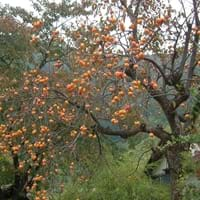Life Span
Perennial
Perennial
Type
Bulb or Corm or Tuber
Tree
Origin
South America
China, Korea
Types
Pamianthe cardenasii , Pamianthe parviflora , Pamianthe peruviana
Fuyu Persimmons
Hachiya Persimmons
Among(Ye mon)
Maru Persimmons
Number of Varieties
Not Available
Habitat
All sorts of environments
Woodlands
USDA Hardiness Zone
8-10
6-10
Sunset Zone
21,22
H1, 6, 7, 8, 9, 12, 14, 15, 16, 18, 19, 20, 21, 22, 23, 24
Habit
Clump-Forming
Pyramidal
Flower Color
White
Light Yellow
Flower Color Modifier
Bicolor
Bicolor
Leaf Color in Spring
Dark Green
Green
Leaf Color in Summer
Light Green
Green
Leaf Color in Fall
Several shades of Green
Yellow, Burgundy, Orange Red
Leaf Color in Winter
Light Green
Not Available
Leaf Shape
Strap shaped
Elliptic
Plant Season
Spring, Summer, Fall
Summer, Fall, Winter
Sunlight
Partial Sun, Partial shade
Full Sun, Partial Sun
Type of Soil
Loam, Sand
Clay, Loam
The pH of Soil
Acidic, Neutral, Alkaline
Acidic, Neutral
Soil Drainage
Average
Well drained
Bloom Time
Spring, Late Spring, Early Summer, Summer, Late Summer
Summer
Tolerances
Drought
Not Available
Where to Plant?
Ground, Pot
Ground
How to Plant?
Offsets
Seedlings
Plant Maintenance
Medium
Medium
Watering Requirements
Keep the ground moist but not water-logged
Do not water excessively, Do not water frequently, Prefer drip-irrigation instead of Over-head watering
In Summer
Lots of watering
Lots of watering
In Spring
Moderate
Moderate
In Winter
Average Water
Average Water
Soil pH
Acidic, Neutral, Alkaline
Acidic, Neutral
Soil Type
Loam, Sand
Clay, Loam
Soil Drainage Capacity
Average
Well drained
Sun Exposure
Partial Sun, Partial shade
Full Sun, Partial Sun
Pruning
Pinch or prune as they grow to promote branching and bushiness, Remove damaged leaves, Remove dead branches, Remove dead leaves, Requires little pruning
Remove damaged leaves, Remove dead branches, Remove dead leaves
Fertilizers
All-Purpose Liquid Fertilizer, High phosphorus
All-Purpose Liquid Fertilizer, Apply N-P-K
Pests and Diseases
Leaf spot, Mosaic viruses
Caterpillars, Mealybugs, Nematodes, Red blotch
Plant Tolerance
Drought
Drought, Full Sun, Variety of soil types
Flowers
Showy
Insignificant
Flower Petal Number
Single
Single
Foliage Texture
Coarse
Medium
Foliage Sheen
Glossy
Glossy
Self-Sowing
Yes
Not Available
Attracts
Bees, Birds, Bumblebees, Butterflies, Hummingbirds, pollinators
Birds
Allergy
Unknown
Not Available
Aesthetic Uses
Beautification, Bouquets, Ornamental use, Showy Purposes
Bonsai
Beauty Benefits
No Beauty Benefits
Not Available
Environmental Uses
Air purification
Air purification
Medicinal Uses
No Medicinal Use
Anthelmintic, Antitussive, Antivinous, Appetizer, Astringent, Demulcent, Expectorant, Laxative
Part of Plant Used
Not Available
Fruits
Other Uses
Beneficial species for attracting pollinators, Decoration Purposes
Cosmetics
Used As Indoor Plant
No
No
Used As Outdoor Plant
Yes
Yes
Garden Design
Bog Garden, Container, Feature Plant, Foundation, Mixed Border, Water Gardens
Edible, Fruit / Fruit Tree, Topiary / Bonsai / Espalier
Botanical Name
HYMENOCALLIS longipetala
DIOSPYROS kaki 'Hongsi'
Common Name
Peruvian Daffodil, Spiderlily
Asian Persimmon, Hongsi Persimmon, Japanese Persimmon, Kaki
In Hindi
peruvian daffodil
Japanese Persimmon
In German
peruvian daffodil
Japanese Persimmon
In French
peruvian daffodil
Persimmon japonais
In Spanish
Pamianthe
El caqui japonés
In Greek
peruvian daffodil
Ιαπωνικά Λωτός
In Portuguese
peruvian daffodil
Persimmon japonês
In Polish
peruvian daffodil
japoński Persimmon
In Latin
peruvian daffodil
Persimmon Italica
Phylum
Magnoliophyta
Tracheophyta
Class
Liliopsida
Magnoliopsida
Order
Asparagales
Ericales
Family
Amaryllidaceae
Ebenaceae
Genus
Pamianthe
Diospyros
Clade
Angiosperms, Monocots
Angiosperms, Asterids, Eudicots
Tribe
Clinantheae
Not Available
Subfamily
Amaryllidoideae
Not Available
Number of Species
Not Available
Season and Care of Peruvian Daffodil and Japanese Persimmon
Season and care of Peruvian Daffodil and Japanese Persimmon is important to know. While considering everything about Peruvian Daffodil and Japanese Persimmon Care, growing season is an essential factor. Peruvian Daffodil season is Spring, Summer and Fall and Japanese Persimmon season is Spring, Summer and Fall. The type of soil for Peruvian Daffodil is Loam, Sand and for Japanese Persimmon is Clay, Loam while the PH of soil for Peruvian Daffodil is Acidic, Neutral, Alkaline and for Japanese Persimmon is Acidic, Neutral.
Peruvian Daffodil and Japanese Persimmon Physical Information
Peruvian Daffodil and Japanese Persimmon physical information is very important for comparison. Peruvian Daffodil height is 61.00 cm and width 61.00 cm whereas Japanese Persimmon height is 760.00 cm and width 550.00 cm. The color specification of Peruvian Daffodil and Japanese Persimmon are as follows:
Peruvian Daffodil flower color: White
Peruvian Daffodil leaf color: Dark Green
Japanese Persimmon flower color: Light Yellow
- Japanese Persimmon leaf color: Green
Care of Peruvian Daffodil and Japanese Persimmon
Care of Peruvian Daffodil and Japanese Persimmon include pruning, fertilizers, watering etc. Peruvian Daffodil pruning is done Pinch or prune as they grow to promote branching and bushiness, Remove damaged leaves, Remove dead branches, Remove dead leaves and Requires little pruning and Japanese Persimmon pruning is done Remove damaged leaves, Remove dead branches and Remove dead leaves. In summer Peruvian Daffodil needs Lots of watering and in winter, it needs Average Water. Whereas, in summer Japanese Persimmon needs Lots of watering and in winter, it needs Average Water.





